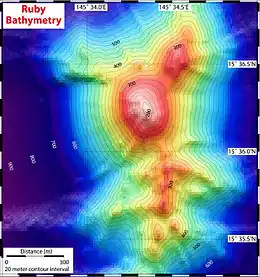| Ruby Seamount | |
|---|---|
 Major volcanoes of the Mariana Islands | |
 Ruby Seamount bathymetry | |
| Summit depth | 175 m (574 ft)[1] |
| Location | |
| Location | Pacific Ocean |
| Group | Izu–Bonin–Mariana Arc |
| Coordinates | 15°37′12″N 145°34′12″E / 15.62000°N 145.57000°E[2] |
| Country | Commonwealth of Northern Mariana Islands, United States |
| Geology | |
| Type | Seamount |
| Age of rock | |
| Last eruption | 15th September 2023 |
Ruby Seamount is an active volcanic seamount in the Northern Mariana Islands region of the Pacific Ocean about 50 km (31 mi) north-west of Saipan.[5][2] It is in a region where the Pacific Plate is subducting under the Philippine Sea Plate producing arc volcanism.
Eruptions
A submarine eruption occurred during a period of about 12 hours between 14 and 15 September 2023, and it also erupted in 1966 and between 11 and 23 October 1995.[5][2]
Geology
Ruby Seamount is a stratovolcano with a more shallow southern peak,[5] and is part of the nine volcano Southern Seamount Province of the Mariana Arc, in the Izu–Bonin–Mariana Arc.[3]: 151 Its location is consistent with it being a back-arc extension associated volcano. Samples of lava have been characterised as arc tholeiitic basalts,[3] suggestive that the magma source was from mantle overlying, not beneath, the subducting Pacific Plate.[4]: 15092–3 The age of the volcano is unknown but nearby basalts have been dated at about 2 million years old,[4]: 15094–6 so it likely started forming more recently than this.
Hydrothermal activity was demonstrated in 2006 with alkaline, ferrous ion and carbon dioxide venting at 200 m (660 ft) depth.[1]: 7, 11 The ratio of CO2 / 3He flux observed at Ruby is amongst the highest ever reported, which is consistent with volcanism involving a deep magma source from slab derived carbonate containing rocks.[1]: 18
Depth revision
Prior to the 1995 eruption the depth was accepted as 230 m (750 ft),[2] but several reports of shallower depths followed the eruption including one of only about 60 m (200 ft) exist.[5] A high quality survey in 2003 gave a depth of 180 m (590 ft) with the peak of North Ruby having a depth of 726 m (2,382 ft).[6]: 16 The next high quality survey in 2006 gave a new depth of 175 m (574 ft).[1]: 11
Ecology
A unique ecosystem of crabs and limpets has been described on the flanks of the volcano.[7]
Name
It was first named as Ruby Volcano in the 1973 paper that described some of the 1966 eruption evidence.[8]
References
- 1 2 3 4 Resing, JA; Baker, ET; Lupton, JE; Walker, SL; Butterfield, DA; Massoth, GJ; Nakamura, KI (2009). "Chemistry of hydrothermal plumes above submarine volcanoes of the Mariana Arc". Geochemistry, Geophysics, Geosystems. 10 (2). doi:10.1029/2008GC002141.
- 1 2 3 4 "Northern Mariana Islands Volcano Observatory Daily update U.S. Geological Survey Wednesday, September 20, 2023, 11:10 AM ChST (Wednesday, September 20, 2023, 01:10 UTC)". Retrieved 20 September 2023.
- 1 2 3 Stern, Robert J; Bloomer, Sherman H; Lin, Ping-Nan; Smoot, N Christian (1989). "Submarine arc volcanism in the southern Mariana Arc as an ophiolite analogue". Tectonophysics. 168 (1–3): 151–170. doi:10.1016/0040-1951(89)90374-0. ISSN 0040-1951.
- 1 2 3 Marlow, MS; Johnson, LE; Pearce, JA; Fryer, PB; Pickthorn, LB; Murton, BJ (10 October 1992). "Upper Cenozoic volcanic rocks in the Mariana forearc recovered from drilling at Ocean Drilling Program Site 781: Implications for forearc magmatism" (PDF). Journal of Geophysical Research: Solid Earth. 97 (B11): 15085–97. doi:10.1029/92JB01079.
- 1 2 3 4 "Global Volcanism Program: Ruby". Retrieved 20 September 2023.
- ↑ Merle, Susan; Embley, Robert W.; Baker, Edward T.; Chadwick, Bill. "Submarine Ring of Fire 2003 – Mariana Arc R/V T. G. Thompson Cruise TN-153 February 9 - March 5, 2003 Guam to Guam" (PDF). Retrieved 20 September 2023.
- ↑ "NOAA:Explorations:Submarine Ring of Fire 2006:Logs:Ruby Submarine Volcano". Retrieved 20 September 2023.
- ↑ Johnson, Rockne H (1973). "Acoustic observations of nonexplosive submarine volcanism". Journal of Geophysical Research. 78 (26): 6093–6096. doi:10.1029/JB078i026p06093.